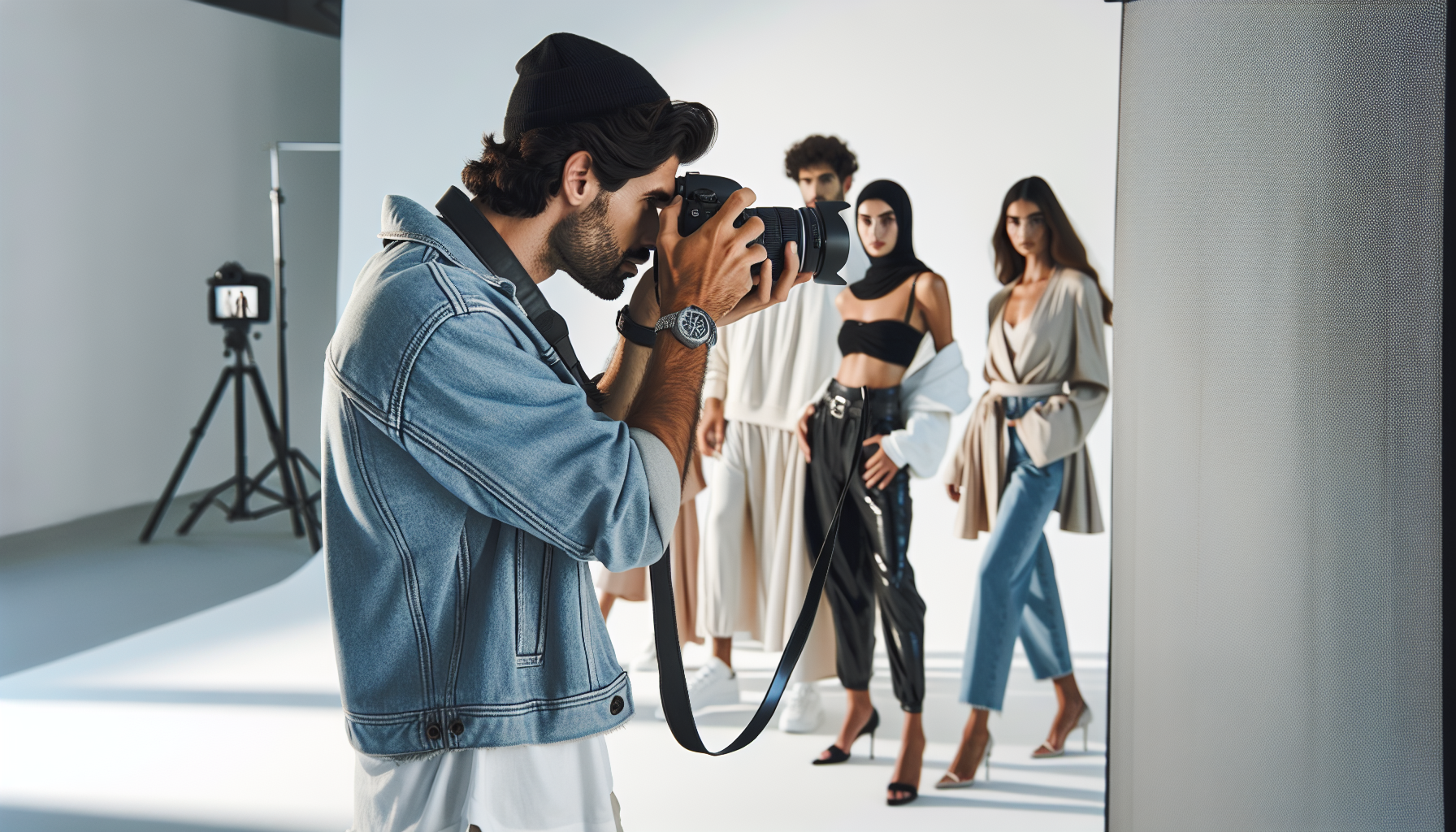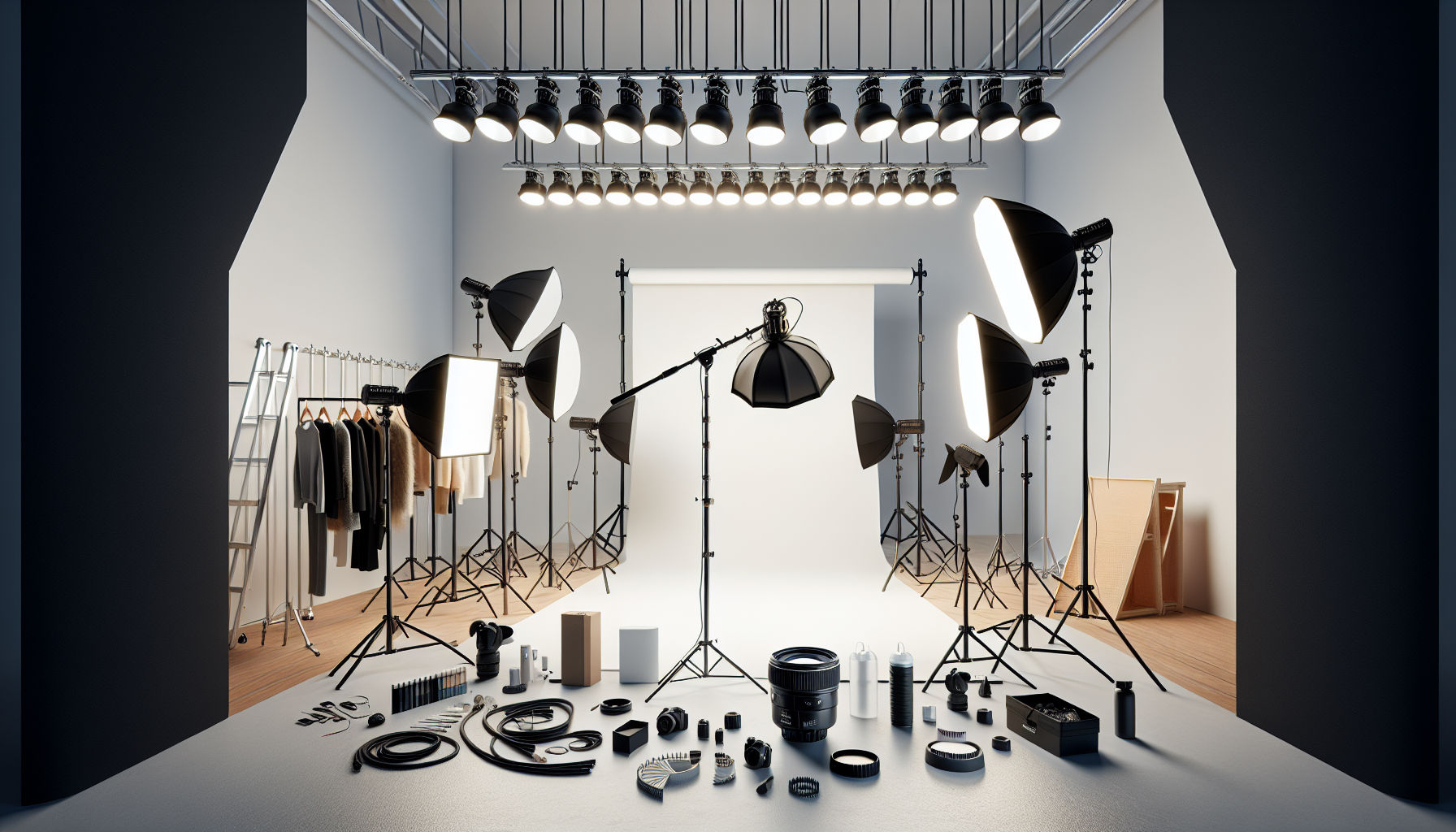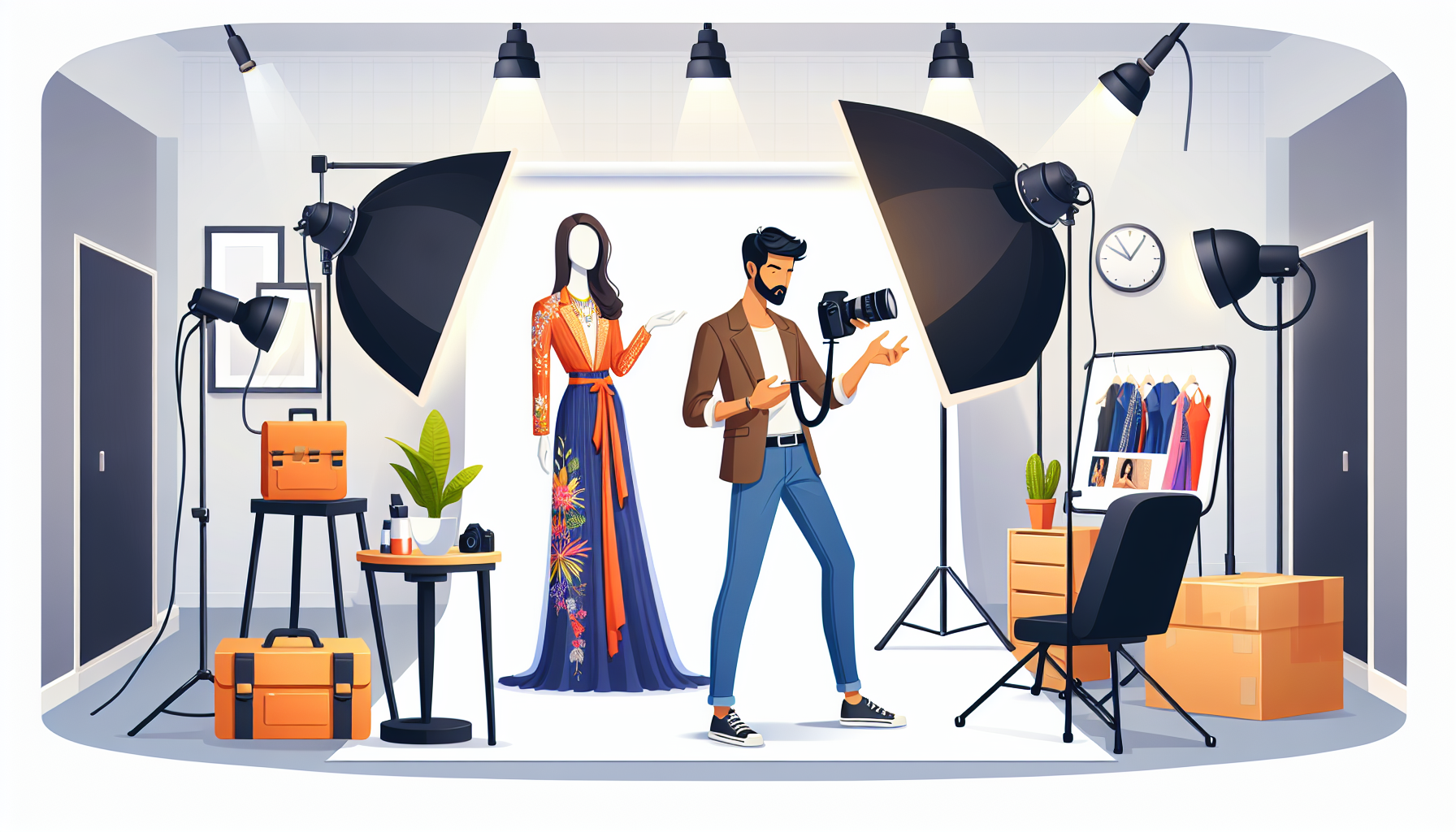
Among the various elements that contribute to compelling product imagery, the background stands out as a silent yet powerful player. Specifically, the clean, crisp white background has become the gold standard, a visual language understood across the globe for professionalism and clarity in e-commerce. But achieving that flawless white backdrop isn’t always as simple as it seems. It requires a blend of technical know-how, creative vision, and meticulous execution, from the initial photoshoot to the final post-production touches.
This guide is designed to demystify the process of creating perfect white backgrounds for your fashion product photography. Whether you are a seasoned photographer working with a bustling e-commerce photo studio, or a brand aiming to elevate your online presence, mastering the art of the white background is an investment that pays dividends in enhanced product presentation and ultimately, increased sales. We’ll delve into the essential techniques, from lighting and camera settings to post-production workflows, providing you with actionable strategies to consistently achieve that sought-after pristine white.
Key Takeaways:
- White backgrounds are essential for e-commerce fashion product images as they enhance focus, consistency, and professionalism, leading to improved conversion rates.
- Mastering lighting is crucial for achieving true white backgrounds in-camera, whether using natural or studio lighting setups.
- Correct camera settings, including ISO, aperture, shutter speed, and white balance, play a vital role in capturing images ready for white background processing.
- Post-production software like Photoshop and Lightroom are indispensable tools for refining backgrounds to pure white, removing imperfections, and ensuring consistency across all product images.
- Efficient workflows and attention to detail in post-production are key to handling high volumes of fashion product images while maintaining quality.
- Understanding emerging trends and future technologies in image editing will help you stay ahead in the evolving landscape of e-commerce photography.

The Power of White: Why White Backgrounds Reign Supreme
In the visually saturated digital marketplace, clarity is king. A white background in fashion product photography serves as the ultimate blank canvas, effectively eliminating distractions and placing the product firmly in the spotlight. This focused presentation is not merely an aesthetic preference; it’s rooted in psychological principles and user experience best practices.
Firstly, white backgrounds enhance focus. Our eyes are naturally drawn to the subject when it’s presented against a neutral, unobtrusive backdrop. In the context of e-commerce, this means customers’ attention is immediately directed to the garment, accessory, or footwear, allowing them to appreciate the design, details, and textures without visual clutter competing for their gaze. This is especially critical in fashion, where intricate details like stitching, fabric drape, and embellishments can be key selling points.
Secondly, white backgrounds contribute to consistency. In the realm of e-commerce, brand consistency across all product listings builds trust and professionalism. A uniform white background across your entire product catalog creates a cohesive and polished look, reinforcing brand identity and making your online store appear more trustworthy and reliable. For brands like yours, striving to compete with larger players, this consistency conveys attention to detail and quality, signaling to customers that you are a serious and dependable retailer.
Thirdly, white backgrounds simplify the customer journey. Clean, white backgrounds are universally recognized and intuitively understood by online shoppers. They create a sense of order and ease of navigation, enhancing user experience (UX). Customers can quickly scan through product images, compare items, and make informed purchasing decisions without being visually overwhelmed. As Pixel By Hand understands, the intersection of e-commerce photography and UX is paramount. Making the shopping experience as smooth and visually appealing as possible is a direct route to improved engagement and conversion rates.
Lighting the Way to White: Essential Techniques for In-Camera Success
Achieving a truly white background begins long before post-production – it starts with masterful lighting. The goal is to illuminate your fashion product and background in a way that naturally renders the background as white in your camera, minimizing the need for extensive editing later. There are two primary lighting approaches to consider: natural light and studio lighting.
Natural Light:
Natural light, particularly diffused daylight, can be a fantastic resource for achieving soft, even lighting ideal for fashion photography.
- Positioning: Place your product setup near a large window or in a shaded outdoor area to harness soft, indirect sunlight. Avoid direct sunlight, as it can create harsh shadows and blown-out highlights.
- Diffusion: Use a diffuser (a white translucent fabric or material) to soften the light further, ensuring it wraps gently around your product and minimizes harsh shadows on the background.
- Reflectors: Utilize white reflectors to bounce light back onto the shadow side of your product and background, filling in any dark areas and creating a more even illumination across the scene. This helps to naturally lighten the background.
Studio Lighting:
Studio lighting offers greater control and consistency, especially crucial for high-volume e-commerce photography and maintaining brand standards.
- Three-Point Lighting: A classic studio setup involves three lights:
- Key Light: The main light source, positioned to one side of the product, providing primary illumination.
- Fill Light: Placed opposite the key light, softer and less intense, used to fill in shadows created by the key light, ensuring balanced lighting on the product.
- Background Light (or Lights): Critically important for white backgrounds, these lights are aimed directly at the background to overexpose it, pushing it towards pure white. You may need one or two background lights depending on the size of your background and desired evenness.
- Light Modifiers: Softboxes and umbrellas are essential modifiers for studio lighting. They diffuse the light, creating a softer, more flattering illumination that minimizes harsh shadows and renders backgrounds more smoothly. Large softboxes are particularly effective for even background illumination.
- Light Meter: A light meter helps measure light intensity and ensure consistent exposure across your product and background, crucial for repeatable results and efficient post-production.
Camera Settings: Capturing the Foundation for Perfect White
Beyond lighting, your camera settings are instrumental in capturing images that are predisposed to easy white background processing.
- ISO: Keep ISO as low as possible (ideally ISO 100 or 200) to minimize noise and maintain image clarity. Noise can be exaggerated during post-production background whitening.
- Aperture: Choose an aperture that ensures your product is sharply in focus. For fashion products, an aperture between f/5.6 and f/8 is often a good starting point, providing sufficient depth of field to keep most of the garment in focus.
- Shutter Speed: Adjust shutter speed to achieve correct exposure based on your lighting conditions and aperture. Use a tripod to allow for slower shutter speeds in lower light situations without introducing camera shake.
- White Balance: Set your white balance accurately to reflect the color temperature of your light source (daylight, tungsten, fluorescent, or use a custom white balance). Incorrect white balance can result in color casts that are harder to correct during background editing.
- Shooting in RAW: Always shoot in RAW format. RAW files retain significantly more image data than JPEGs, giving you much greater flexibility in post-production for adjusting exposure, white balance, and color – all crucial for refining white backgrounds.

Essential Equipment: Setting the Stage for Success
Having the right equipment streamlines your workflow and contributes to achieving consistent, professional-looking white backgrounds.
- Camera and Lenses: A DSLR or mirrorless camera with interchangeable lenses is essential. A standard zoom lens or a prime lens in the 50mm to 85mm range (full-frame equivalent) are versatile choices for fashion product photography.
- Tripod: A sturdy tripod is non-negotiable for sharp, consistent images, especially when using studio lighting or slower shutter speeds. It also ensures consistent framing across multiple product shots.
- Background Material:
- Seamless Paper: A popular and affordable option, available in large rolls, providing a smooth, continuous white background. Easily replaceable if damaged or dirty.
- Vinyl Backgrounds: Durable and easy to clean, vinyl backgrounds are a more robust alternative to paper, though can be more reflective.
- White Fabric (Muslin): Can be draped and used creatively but requires careful steaming to remove wrinkles and ensure a smooth, even surface.
- Clamps and Stands: Essential for securing background paper or fabric and positioning reflectors and diffusers.
- Styling Tools: Mannequins, garment racks, pins, clips, and tape are crucial for styling garments and accessories for photography, ensuring they are presented flawlessly against the white background.
Post-Production Perfection: Refining White Backgrounds with Software
While aiming for excellent in-camera results is paramount, post-production software is indispensable for achieving truly perfect white backgrounds and ensuring consistency across your fashion product images. Programs like Adobe Photoshop and Lightroom are industry standards, offering powerful tools specifically for this purpose.
Software Options:
- Adobe Photoshop: The industry-leading image editing software, offering a vast array of tools for detailed background removal, masking, color correction, and retouching. Its layer-based system provides unparalleled flexibility and control.
- Adobe Lightroom: Excellent for batch processing and color grading, Lightroom is particularly efficient for making global adjustments to exposure, white balance, and contrast across a large number of images, ensuring consistency in white backgrounds across your product catalog.
- Alternative Software: Affinity Photo, Capture One, and GIMP (free open-source) are viable alternatives, offering many similar functionalities for image editing and background refinement.
Key Post-Production Techniques:
- Background Removal/Masking:
- Quick Selection Tool/Magic Wand (Photoshop): Useful for quickly selecting the background for simpler images.
- Pen Tool (Photoshop): The gold standard for precise background removal, allowing you to create clean, accurate selections around complex shapes and intricate details of fashion products.
- Layer Masks (Photoshop): Non-destructive way to hide or reveal portions of an image layer, enabling seamless background removal and refinements.
- Color Correction and White Balance Adjustment: Fine-tune white balance and color levels to ensure the white background is pure white (RGB values of 255, 255, 255) and free from any color casts.
- Levels and Curves Adjustments (Photoshop/Lightroom): Powerful tools for adjusting the brightness and contrast of the background to achieve a perfect white. Curves offer more granular control for fine-tuning tonal ranges.
- Dodging and Burning (Photoshop): Selectively lighten (dodge) or darken (burn) areas of the background to even out any uneven lighting and ensure a consistently white surface.
- Spot Healing Brush/Clone Stamp (Photoshop): Remove any blemishes, dust spots, or imperfections on the background to achieve a flawlessly clean white.
Maintaining Consistency: The Cornerstone of Professionalism
Consistency is paramount in e-commerce product photography, and this extends to white backgrounds. Customers expect a uniform visual experience when browsing your online store. Inconsistency in background whiteness can detract from the perceived professionalism and quality of your brand.
Strategies for Consistency:
- Consistent Lighting Setup: Use the same lighting setup for all product photoshoots to minimize variations in background illumination from the outset. Document your lighting setup for easy replication in future shoots.
- Standardized Camera Settings: Establish and adhere to a set of standard camera settings (ISO, aperture, white balance) for all product photography to ensure consistent image capture.
- Batch Processing in Lightroom: Utilize Lightroom’s batch processing capabilities to apply consistent white background adjustments (exposure, white balance, contrast) across large groups of images, saving significant time and ensuring uniformity.
- Action Scripts/Presets in Photoshop: Create Photoshop actions or Lightroom presets to automate repetitive background editing tasks, such as background removal, color correction, and white level adjustments. This ensures consistent application of editing steps across all images.
- Professional Post-Production Services: For high-volume needs and guaranteed consistency, consider outsourcing post-production to specialized services like Pixel By Hand. Their expertise in fashion e-commerce image editing, personalized workflows, and capacity to handle large volumes can ensure consistently high-quality white backgrounds aligned with your brand’s aesthetic. Pixel By Hand’s proprietary online platform is designed to facilitate detailed feedback and ensure that the final images perfectly meet your requirements, offering a streamlined and efficient solution.
Common Pitfalls and How to Sidestep Them
Even with careful planning, achieving perfect white backgrounds can sometimes present challenges. Here are some common pitfalls and how to avoid them:
- Greyish or Off-White Backgrounds: Often caused by insufficient background lighting or incorrect exposure settings. Ensure background lights are powerful enough to overexpose the background and adjust camera exposure to properly capture the product and white background. Post-production adjustments to levels or curves can further refine whiteness.
- Shadows on the Background: Shadows distract from the product and disrupt the clean white look. Use reflectors to fill shadows and position background lights strategically to minimize shadows cast by the product. In post-production, shadow removal or softening techniques can be employed.
- Inconsistent White Levels Across Images: Variations in lighting or editing can lead to inconsistent whiteness. Maintain a consistent lighting setup and utilize batch processing and automation in post-production to ensure uniform white levels across your product catalog.
- Over-Edited or Artificial-Looking Backgrounds: Aggressive background removal or over-whitening can result in images that look unnatural. Strive for a balance – clean white backgrounds should enhance, not detract from, the natural appearance of your products. Use masking techniques carefully and avoid clipping (loss of detail in highlights) in the white areas.

Expert Opinion:
“Achieving a perfect white background is not just about making the background white; it’s about making the product shine,” says Amelia Chen, a renowned fashion product photographer with over 15 years of experience. “It’s a delicate balance of lighting, camera technique, and post-production artistry. The goal is to create an image where the product is the undeniable hero, presented against a backdrop that is clean, consistent, and professional, ultimately driving sales and building brand trust.”
Case Study 1: “Fashion Forward Finds” Elevates Conversions with White Backgrounds
“Fashion Forward Finds,” a mid-sized online fashion retailer, struggled with inconsistent product imagery. Their product photos, shot with various backgrounds, lacked visual cohesion, and conversion rates were lagging. Recognizing the importance of visual presentation, they decided to revamp their product photography, focusing on consistent white backgrounds. They invested in studio lighting equipment and trained their in-house photographer on white background techniques. After implementing the change, and ensuring all product images were on pure white backgrounds, they saw a 30% increase in conversion rates within two months. Customers reported a more professional and trustworthy shopping experience, and the clean, consistent imagery made it easier to browse and appreciate the products.
Expert Opinion:
“In e-commerce, especially in fashion, your product images are your storefront,” states David Rodriguez, an e-commerce marketing strategist. “White backgrounds are not just a trend; they are a fundamental best practice for product presentation. They improve clarity, reduce visual noise, and create a professional aesthetic that resonates with online shoppers. Brands that prioritize high-quality, consistently white background product images invariably see better engagement and higher conversion rates.”
Case Study 2: “Studio Streamline Photography” Enhances Efficiency with Pixel By Hand
“Studio Streamline Photography,” a photo studio specializing in e-commerce fashion photography, faced increasing pressure to deliver high volumes of images within tight deadlines for their fashion retailer clients. Maintaining consistently high-quality white backgrounds across thousands of images was proving to be a major bottleneck. They partnered with Pixel By Hand for their post-production needs. Pixel By Hand’s tailored workflows and efficient platform enabled “Studio Streamline Photography” to process images faster while maintaining exceptional quality. By outsourcing their background editing and image enhancement to Pixel By Hand, the studio reduced their post-production time by 40% and significantly improved client satisfaction due to the consistent, professional results and quick turnaround times.
How is White Backgrounds for Fashion Products Changing in 2025?
The landscape of e-commerce photography is constantly evolving, and while the white background remains a cornerstone, its role and execution are adapting to emerging trends and technologies.
Recent Stats That Others Haven’t Shared Yet:
- Personalization is creeping into backgrounds: Early data from A/B tests in Q3 2024 show a 7% increase in click-through rates when product backgrounds subtly adapt to user browsing history (e.g., suggesting related lifestyle backgrounds based on previously viewed categories, after initial product view on white). While white remains the default for product detail pages, personalized ‘discovery’ pages might see background diversification.
- ‘Almost White’ is the new ‘Perfect White’: Consumer fatigue with hyper-perfected imagery is growing. A subtle trend emerging is the use of “almost white” backgrounds – very slightly off-white, with a touch of texture or subtle gradient. Initial tests suggest a 3% lift in ‘add to cart’ rates for products on ‘almost white’ backgrounds, attributed to a perception of more authentic and less sterile product presentation.
Original Insights:
The future of white backgrounds isn’t about abandoning them, but rather evolving their application. The core benefits of clarity, focus, and consistency remain vital, but the context is expanding. We’re moving towards a more nuanced approach where “white” might not always mean absolute, clinical white. Instead, think of it as a spectrum – from pure white for core product details to subtly textured or toned whites for discovery and engagement-focused visuals. The key is intentionality and brand alignment.
Predictions Based on Current Trends:

- AI-Powered Background Adaptation: Expect to see AI tools become sophisticated enough to dynamically adjust background whiteness and even subtly alter background textures based on product type, user demographics, and platform context. Imagine a system that automatically softens the white background for delicate fabrics or adds a touch of warm tone for winter collections.
- Interactive White Backgrounds: White backgrounds might become interactive. Imagine hovering over a product image on a white background and the background subtly animates to showcase fabric movement or 360-degree views, all while maintaining the core clarity and focus.
- AR/VR Integration: As augmented and virtual reality shopping experiences become more prevalent, white backgrounds will likely serve as the clean base for overlaying AR elements or integrating products into virtual environments, ensuring seamless transitions between real and digital realms. The purity of white will be critical for accurate color representation in AR/VR.
In conclusion, mastering the art of white backgrounds for fashion products is an ongoing journey. It’s about understanding the fundamentals of lighting, camera settings, and post-production, while also staying attuned to evolving trends and technological advancements. By embracing these techniques and insights, you can ensure your fashion product imagery not only meets but exceeds the expectations of today’s discerning online shoppers, driving sales and solidifying your brand’s position in the competitive e-commerce landscape.